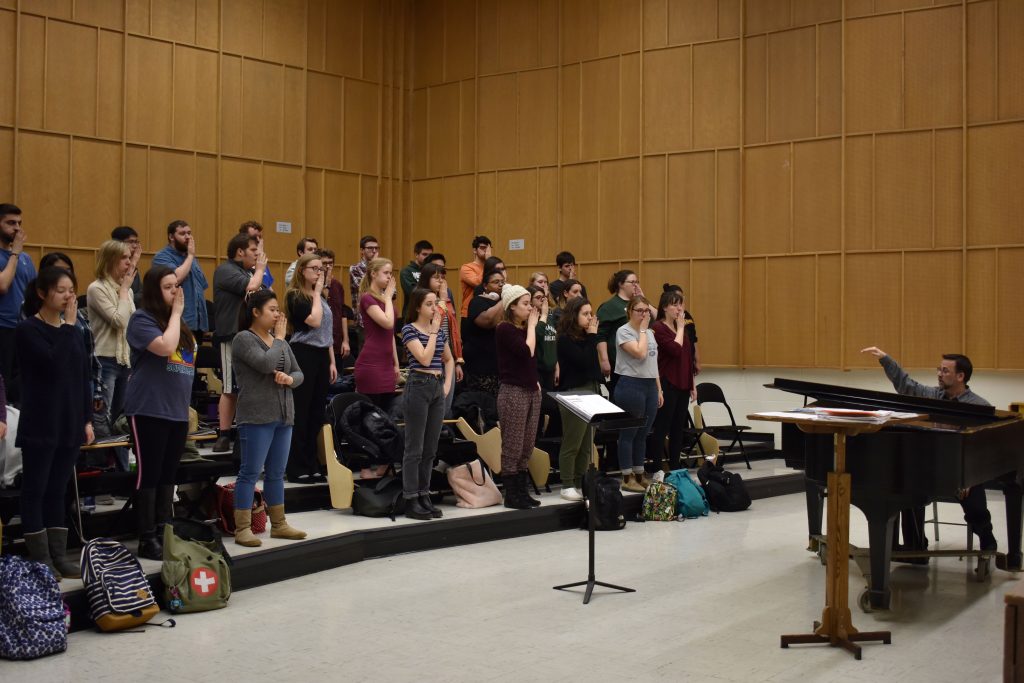
Students stand shoulder to shoulder in a Fine Arts Building classroom. They raise their voices in unison, working together to achieve perfect harmony. They place their trust in the vision of a single man, an expert of his craft. William Culverhouse, director of choral activities and an assistant professor of music at Binghamton University, revels in the passion of his students.
Culverhouse has a long history of performing in and working with choirs; his first experience was when he was in the second grade. Culverhouse said the group setting of a chorus is what he enjoys the most.
“For me, it ultimately comes down to sharing the joy of singing together,” he said.
Culverhouse is at the helm of four different choral groups on campus: Harpur Chorale, Women’s Chorus, Chamber Singers and University Chorus. Each choir occupies a different niche in the department, but Culverhouse puts an equal amount of work into each group.
The Harpur Chorale is composed of singers who widely vary in skill level. Culverhouse said he looks for singers with a common passion for improving themselves as singers and as a group.
“Everyone auditions and we take people at a variety of skill levels,” Culverhouse said. “The goal is to create group art.”
Students with nearly no prior experience singing in a chorus are invited to audition for Harpur Chorale, as Culverhouse works closely to develop each singer’s ability to read music and to better their auditory memory. The group has seen a jump in membership to 56 members recently — a 20 percent growth in membership from last semester.
Carina Kahane, a senior majoring in English, is required to perform in the Harpur Chorale for her minor in vocal performance, but said she has valued Culverhouse’s guidance.
“It’s been a really great experience,” Kahane said. “I don’t know if I’ve met anyone more dedicated.”
The Women’s Chorus is made up of female vocalists, and its repertoire features only pieces by female composers. There is often crossover in membership between Women’s Chorus and Harpur Chorale, but the Women’s Chorus provides a specific and exclusive outlet.
Culverhouse’s empowerment of women in the choral groups, however, extends through the department, as each group always has at least one song by a female composer in its program.
Courtney Densmore, a senior majoring in English, has performed in both the Women’s Chorus and the Harpur Chorale, and said she values singing with a chorus as a community and creative outlet.
“I love the sense of togetherness and inclusivity in the choral music program,” Densmore said. “The sense of escape it gives me from my day-to-day life as a student is a huge source of stress relief.”
The Chamber Singers, which requires a more advanced audition process, is composed of 17 vocalists from both Harpur Chorale and Women’s Chorus. These singers are chosen on their sight-reading ability, vocal quality and versatility. Sam Chosack, a senior majoring in music, explained that being in the advanced group is both challenging and fulfilling.
“In order to really succeed in the Chamber Singers, you need to be really comfortable with your instrument — that being your voice,” Chosack said. “It’s a really beautiful sound. It’s more cohesive, it’s very pure. It’s just a delight to listen to.”
The University Chorus is a mix of students and community members that often collaborates with music professor Timothy Perry’s University Symphony Orchestra. Its most recent performance last September explored how architecture reflects music performance, drawing inspiration specifically from early 17th-century Venetian cathedrals. Culverhouse puts a lot of emphasis on this kind of collaboration with other music groups, and said he plans to perform with local high school choirs at the University this September.
Each chorus is preparing for the department’s May 3 concert, the “Choral Celebration.” Culverhouse described the event as a “festive smorgasbord,” which he hopes will include a great deal of diversity.
“I love doing music from cultures that are … not as well-represented within the traditional Western music canon,” he said. “There’s just so much terrific music out there that’s not getting heard … it’s a lot of fun to bring that music to the public.”
One thing is for certain: Culverhouse’s students support his vision.
“His mastery of the material … I’ve never experienced anyone better,” Chosack said. “Even if you’re having a bad day and you don’t feel like giving your all in practice, he manages to make it infectious. He makes you want to get involved in the music.”


